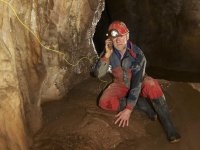Big downside of these sets is cave conservation, often in the past after a major rescue or flooding in a rescue have caused these lines to become abandoned and litter the cave. With as you say possibility of many kms of line, then not only do they require quite a few personnel to bring them in, they are also a mammoth task to bring back out again all when everyone's primary concern is the causality or the safety of their team meets, I can see why these have been left in caves in the past.
True in the days of No 9 BT steel drop wire which was available in vast quantities. With PTFE coated thin gauge wire cleaning up, and laying, is a much less onerous task. There is really no excuse to not clearing up. Having organised several cleanups of old wire I will be the first to admit that there are still miles of the old stuff in some long SW caves, usually crammed up in some convenient corner or buried in a choke. The same goes for a lot of bang wire. I think (hope) teams and cavers have moved forward on the conservation front.
Jopo




